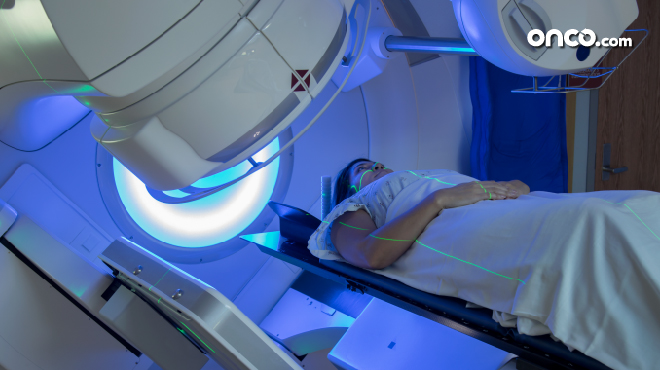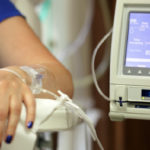What is radiation treatment for breast cancer?
Radiation treatment for breast cancer refers to the use of high-energy X-rays, or other radioactive particles to target and destroy cancer cells in the breasts. Radiation oncologists identify and prescribe the right treatment to cancer patients.
What are the types of radiation treatment for breast cancer?
The most common type of radiation treatment for breast cancer is external beam radiation therapy (EBRT). Other forms of radiation treatments include:
- Intraoperative radiation therapy (radiation treatment with a probe during surgery)
- Brachytherapy (radiation from one or more radioactive sources directly inside or near the tumor)
- For breast cancer patients, a radiation therapy schedule usually consists of a specific number (cycle) of treatments given over a set period and then repeated periodically.
Radiation treatment before surgery for breast cancer treatment (Neoadjuvant Radiation Therapy)
When radiation therapy is given before surgery to shrink a large tumor, it is called neoadjuvant radiation therapy. It makes the tumor easier to remove. However, this is an unusual approach and only applied when tumors are complicated to remove with surgery alone.
Adjuvant Radiation Therapy (Radiation treatment after surgery for breast cancer)
Radiation treatment after surgery is called adjuvant radiation therapy. It is a part of breast-conserving surgery (BCS/Lumpectomy). The need for radiation after surgery depends on the stage of the disease, type of surgery performed, and other high-risk factors for recurrence on final biopsy report.
Radiation after lumpectomy:
Most commonly, doctors recommend external-beam radiation therapy after lumpectomy, usually for five days at a stretch, for five to six weeks. For the first four to five weeks, the administration is to the whole breast, and in the following weeks, it becomes more focused to target the site of the tumor. This concentrated part of the treatment is the Boost. The type of technique and fractionation depends on the treating radiation oncologist.
Radiation after mastectomy:
After breast removal surgery (mastectomy), radiation treatment lasts five days a week, for five to six weeks. Radiation therapy in cases of mastectomy to the chest wall and the involved nodes to prevent local recurrence. It is generally given in locally advanced breast cancers and some cases of early breast cancers based on final biopsy report.
Other types of radiation treatment used for breast cancer treatment
Partial breast irradiation (PBI)
Partial breast irradiation (PBI) is a type of radiation therapy aimed directly at the tumor area, instead of the entire breast. Doctors recommend PBI as adjuvant therapy after a lumpectomy. Using PBI, the overall time of radiation exposure for each patient can be controlled or reduced. However, only a selected number of patients are eligible for PBI instead of complete breast radiation.
Intensity-modulated radiation therapy (IMRT)
Intensity-modulated radiation therapy, or IMRT, is a more advanced form of external-beam radiation treatment to the breast. In IMRT, the radiation intensity is varied to target better the tumor, which in turn spreads the radiation more evenly throughout the breast. Using IMRT helps in reducing the radiation dose, and decreases any possible damage to nearby organs such as the heart and the lungs. IMRT also helps in controlling other radiation side effects, such as skin peeling. Women with larger breasts are at higher risk for these side effects as compared to women with smaller breasts, and can, therefore, benefit more from IMRT. Hardness, swelling, and radiation-caused discoloration can be of less occurrence with IMRT.
Proton beam therapy
Standard radiation treatment refers to X-rays, which is also called photon therapy since X-rays use photons. There is another type of external beam radiation therapy, called proton beam therapy (or PBT), which used protons instead of X-rays. Protons are theoretically more effective in destroying cancer cells due to their high energy coefficients. The different physical properties of protons also allow PBT to target tumor cells more effectively than photon therapy, and this can be used as an advantage to reduce the overall radiation dose. Proton beam therapy is still very new and not widely available.
Use of radiation therapy to control breast cancer recurrence/relapse
Radiation is an effective measure to reduce the risk of cancer recurrence. In developed nations, the rates of recurrence have gone down to less than 5% (calculated for patients who have completed ten years after treatment, on average).
Side effects of radiation treatment in breast cancer patients
Radiation therapy exposes different cells and tissues in the body to radioactivity, and can, therefore, cause a variety of side effects, including:
- Fatigue
- Swelling of the breast
- Redness of the skin of breasts
- Skin discoloration
- Skin hyperpigmentation (increase in color density)
- Pain or burning sensation in the skin of the local region
- Blistering or peeling of the skin around the breasts
- Pneumonitis (a radiation-related swelling of the lung tissue)
- Occasional risk of heart disease (very rare, due to long term radiation exposure)
Side effects of radiation treatment for breast cancer
Although radiation treatment for breast cancer is an extremely effective form of treatment, there can be some mild-to-severe side effects of radiation exposure to the breast. Some of these side effects can begin during treatment, while others can arise months or years after the procedure.
The most common side effects of radiation treatment in breast cancer include:
Pain and skin changes
During and just after receiving radiation, the treated breast can become sore. The treated breast may also become rough to the touch, or red (which feels like a sunburn) and swollen. Sometimes the skin on the breasts can peel off. There can be moist reactions, where the skin keeps peeling in layers and the area becomes tender, and sensitive; this happens commonly in the folds of the skin on the breasts, and the skin on the bottom side of the breasts.
Fatigue
Fatigue is a pervasive side effect of radiation treatment for breast cancer. It can present itself during treatment, or months after radiation therapy and continue to last for several weeks or months after the treatment ends.
Breast and skin changes
Over time, patients may experience either firmness or shrinkage of one breast or both breasts. Mild tanning of the skin in the local region of the breast, or some form of red discoloration, especially around (any) surgical scar(s) is possible because of radiation exposure. These changes can become permanent.
Lymphedema
In this condition, fluid collects in the underarm area and other areas where lymph nodes are present, causing them to swell up. Chances of lymphedema are higher in patients who have received adjuvant (post-surgical) radiation therapy to the lymph node area, and to patients who have had an axillary lymph node dissection before receiving radiation treatment.
Aside from the above-mentioned common side effects, some of the rare side effects of radiation treatment for breast cancer patients, include:
- Nausea and hair loss (more commonly seen as a side effect of chemotherapy)
- Rib fractures
- Heart problems (cardiotoxicity)
- Lung complications, extending to potential lung cancer due to radiation exposure
- Nerve problems, such as brachial plexopathy




